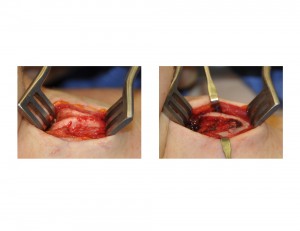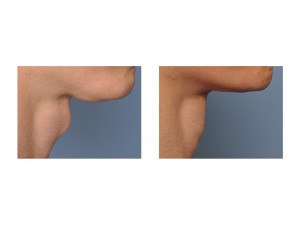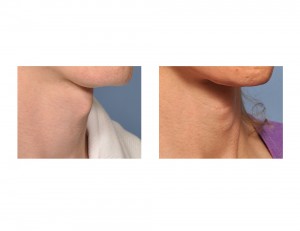Background: The bulge in the center of just about any neck is the result of the laryngeal prominences. These are two large plates of paired cartilages who have a primary function to provide protection of the very important vocal cords from injury The size or prominence of these cartilages is highly influenced by hormones which is why men have larger laryngeal cartilages than women. As a secondary sexual characteristic, its presence is highly associated with being a male feature.
As an aside, the neck laryngeal prominence is commonly called the ‘Adam’s Apple. It is a commonly held belief that this term comes from a piece of forbidden fruit embedded in the first man’s (Adam ) throat. This sounds somewhat logical but there is no mention of any such reference of it happening in the Bible. It is postulated that a far more likely explanation are translation errors. Latin translation from Hebrew confuses the word ‘bump’ to be ‘apple’ and the word ‘man’ to be ‘Adam’. Hence ‘man bump’ has become ‘Adam’s Apple’.
Because the Adam’s Apple is a highly recognized male feature, it has become an important area of treatment in facial feminization surgery. Getting rid of an obvious and prominent neck bulge and creating a smooth more feminine neck line is a small but important change. Known more commonly as a tracheal shave, technically a reduction chondrolaryngoplasty, it is a fairly simple and uncomplicated procedure.
While a tracheal shave is most commonly recognized as a transgender facial feminization surgery procedure, it is done just about as often in non-transgender men. The difference in treating these two patient populations for tracheal shave reduction is a matter of degree. In facial feminization patients, an aggressive and maximal reduction of the neck bulge is needed to achieve a flat and smooth as neckline as possible. The reduction needs to be less aggressive in other men who still want to leave some semblence of an identifiable male neck bulge.
Case Study: This 36 year-old transgender female wanted to reduce a very prominent Adam’s apple. Her overall face and neck was very thin with little subcutaneous fat but was strongly skeletonized with prominent bone and cartilage structures. As part of numerous other facial feminization procedures, a tracheal shave reduction was comboned with brow bone reduction and rhinoplasty surgery.



Case Highlights:
1) A tracheal shave can be done successfully and discretely through a small incision directly over the laryngeal prominence.
2) Significant tracheal reduction can be done without voce changes under general anesthesia.
3) Tracheal shave reduction is one of many facial feminization surgery procedures for transgender patients that can be combined with any number of other procedures.
Dr. Barry Eppley
Indianapolis, Indiana


